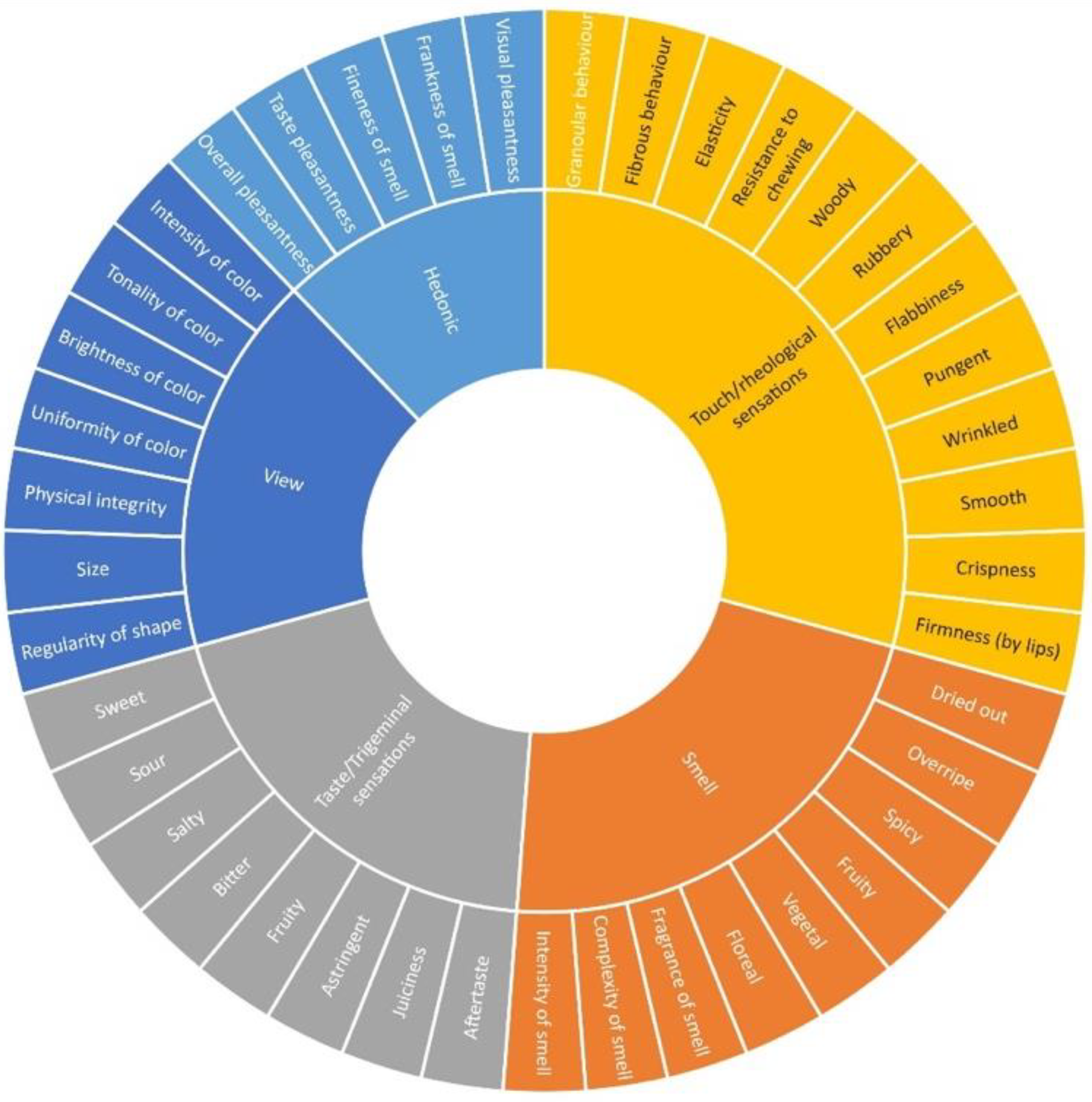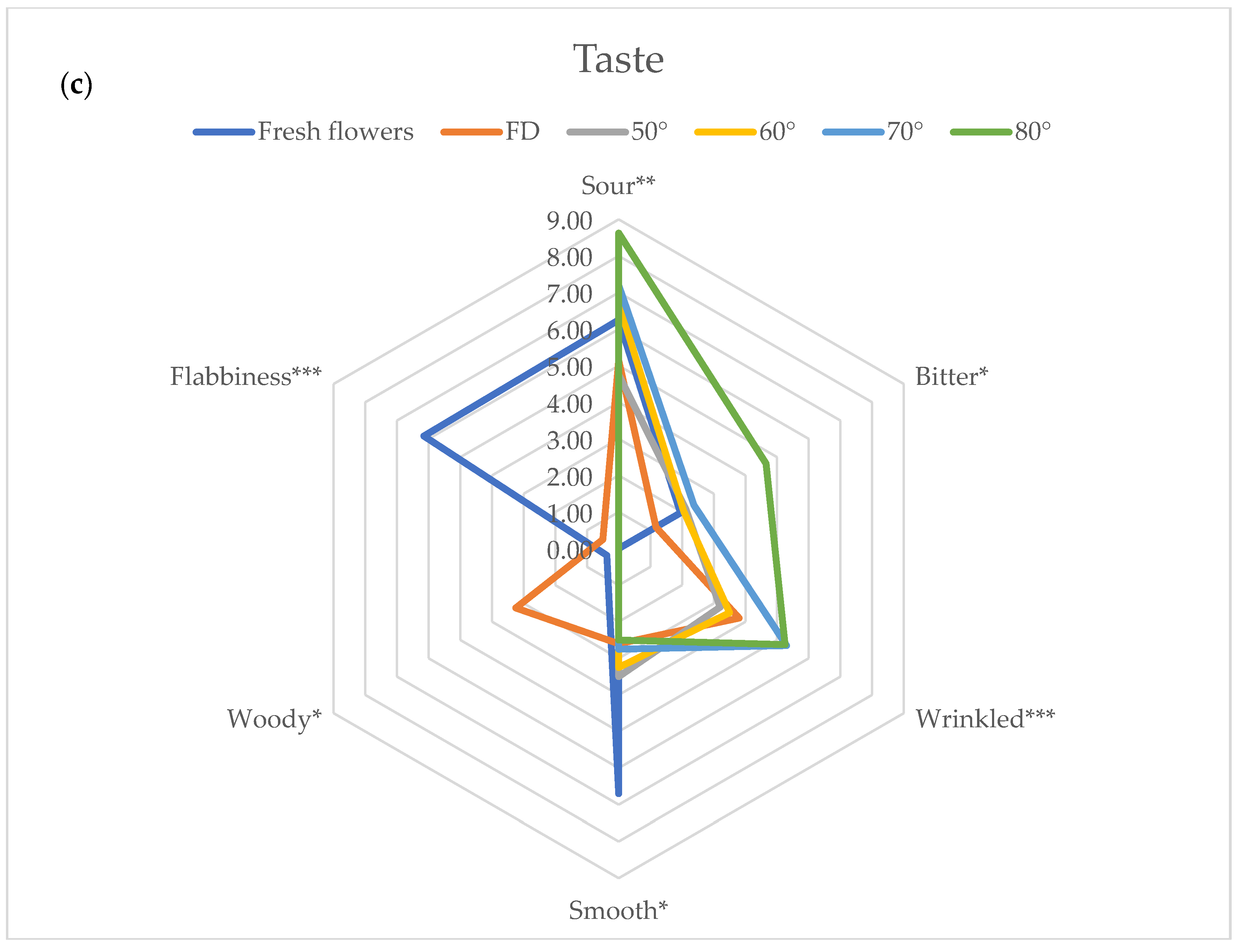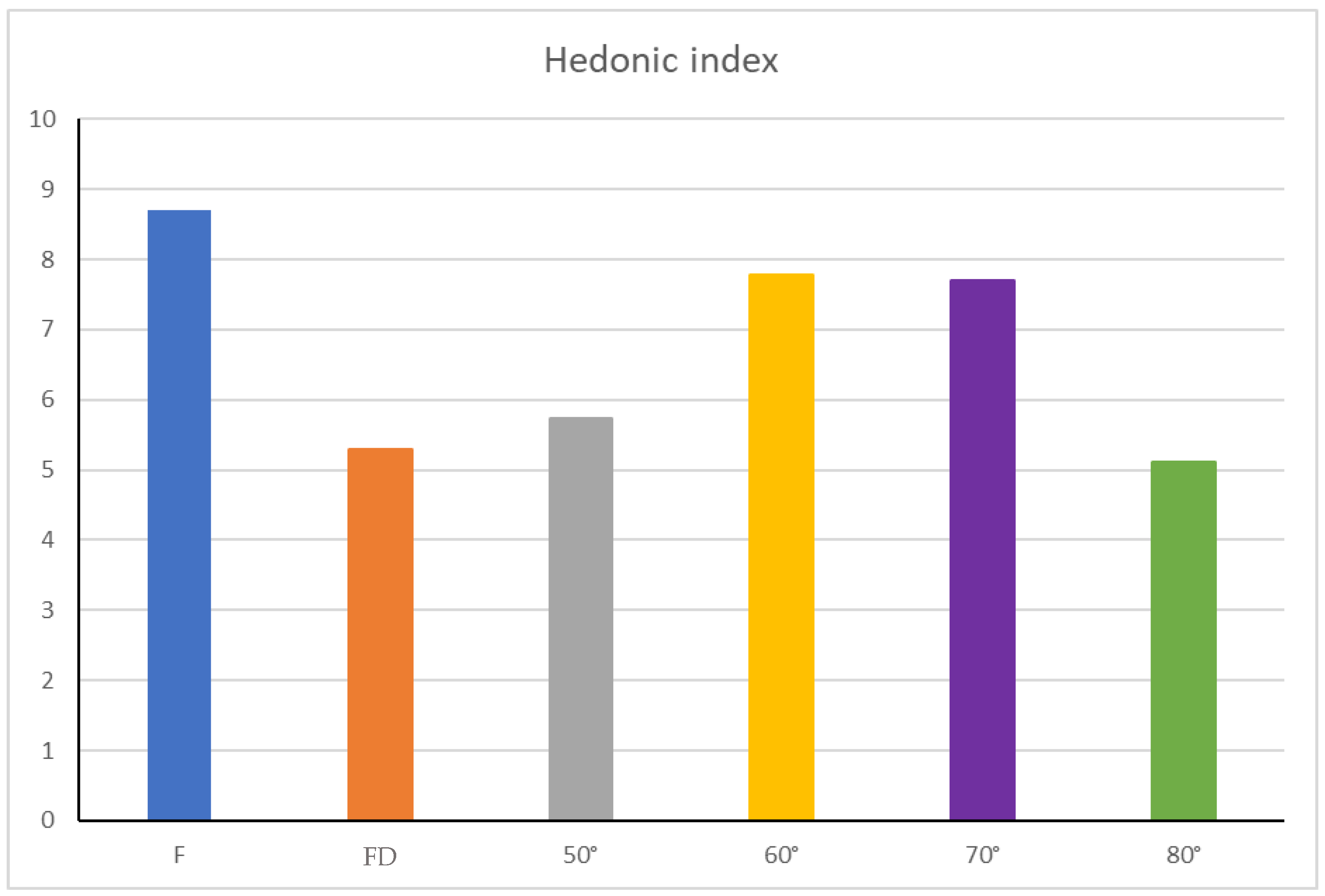Postharvest Treatments on Sensorial and Biochemical Characteristics of Begonia cucullata Willd Edible Flowers
Abstract
:1. Introduction
2. Materials and Methods
2.1. Chemicals
2.2. Plant Material and Cultivation
2.3. Postharvest Treatments
2.4. Color Parameters
2.5. Descriptive Sensory Evaluation
2.6. Biochemical Analyses
2.7. Statistical Analysis
3. Results and Discussion
3.1. Colorimetric Analysis
3.2. Descriptive Sensory Evaluation
3.3. Biochemical Analyses
4. Conclusions
Author Contributions
Funding
Institutional Review Board Statement
Informed Consent Statement
Data Availability Statement
Conflicts of Interest
References
- Mlcek, J.; Rop, O. Fresh edible flowers of ornamental plants—A new source of nutraceutical foods. Trends Food Sci. Technol. 2011, 22, 561–569. [Google Scholar] [CrossRef]
- Lim, T.K. Edible Medicinal and Non Medicinal Plants. Flowers; Springer: Dordrecht, The Netherlands, 2014; Volume 8. [Google Scholar]
- McLellan, T.; Cloete, E.C.; Bosa, A.J.N. Naturalization of Begonia cucullata in the Port St. Johns region, Transkei. S. Afr. J. Bot. 1994, 60, 136–137. [Google Scholar] [CrossRef] [Green Version]
- Kereša, S.; Mihovilović, A.; Barić, M.; Jerčić, I.H. Efficient plant regeneration of Begonia semperflorens and Begonia spp. from petiole and leaf explants. J. Food Agric. Environ. 2011, 9, 240–244. [Google Scholar]
- Couplan, F. Mangez vos Soucis: Plantes Ornementales Comestibles et Leurs Usages; Sang de la Terre: Paris, France, 2011; ISBN 978-2-86985-260-0. [Google Scholar]
- Karima, S.; Nadine, C.; Fadila, B.; Maurice, J. Characterization and Distribution of Flavonoids from Flowers in Different Horticultural Types of Begonia. Pharmacogn. J. 2017, 9, 850–855. [Google Scholar] [CrossRef] [Green Version]
- Chensom, S.; Okumura, H.; Mishima, T. Primary screening of antioxidant activity, total polyphenol content, carotenoid content, and nutritional composition of 13 edible flowers from Japan. Prev. Nutr. Food Sci. 2019, 24, 171–178. [Google Scholar] [CrossRef] [PubMed]
- Kwon, J.-H.; Oh, H.-J.; Lee, D.-S.; In, S.-J.; Seo, K.-H.; Jung, J.-W.; Cha, B.-J.; Lee, D.Y.; Baek, N.-I. Pharmacological activity and quantitative analysis of flavonoids isolated from the flowers of Begonia semperflorens Link et Otto. Appl. Biol. Chem. 2019, 62, 11. [Google Scholar] [CrossRef]
- Fernandes, L.; Casal, S.; Pereira, J.A.; Saraiva, J.A.; Ramalhosa, E. Edible flowers: A review of the nutritional, antioxidant, antimicrobial properties and effects on human health. J. Food Compos. Anal. 2017, 60, 38–50. [Google Scholar] [CrossRef]
- Landi, M.; Ruffoni, B.; Combournac, L.; Guidi, L. Nutraceutical value of edible flowers upon cold storage. Ital. J. Food Sci. 2018, 30, 336–347. [Google Scholar] [CrossRef]
- Safeena, S.A.; Patil, V.S. Studies on the effect of microwave oven drying on flower quality of dried dutch rose flowers. Natl. Acad. Sci. Lett. 2014, 37, 19–24. [Google Scholar] [CrossRef]
- Hnin, K.K.; Zhang, M.; Ju, R.; Wang, B. A novel infrared pulse-spouted freeze drying on the drying kinetics, energy consumption and quality of edible rose flowers. LWT 2021, 136, 110318. [Google Scholar] [CrossRef]
- Fernandes, L.; Saraiva, J.A.; Pereira, J.A.; Casal, S.; Ramalhosa, E. Post-harvest technologies applied to edible flowers: A review: Edible flowers preservation. Food Rev. Int. 2019, 35, 132–154. [Google Scholar] [CrossRef]
- Zhao, L.; Fan, H.; Zhang, M.; Chitrakar, B.; Bhandari, B.; Wang, B. Edible flowers: Review of flower processing and extraction of bioactive compounds by novel technologies. Food Res. Int. 2019, 126, 108660. [Google Scholar] [CrossRef] [PubMed]
- Husti, A.; Cantor, M.; Buta, E.; Horț, D. Current trends of using ornamental plants in culinary arts. ProEnvironment Promediu 2013, 6, 52–58. [Google Scholar]
- Qiu, L.; Zhang, M.; Bhandari, B.; Wang, B. Effects of infrared freeze drying on volatile profile, FTIR molecular structure profile and nutritional properties of edible rose flower (Rosa rugosa flower). J. Sci. Food Agric. 2020, 100, 4791–4800. [Google Scholar] [CrossRef] [PubMed]
- Duan, X.; Zhang, M.; Mujumdar, A.S.; Wang, R. Trends in microwave-assisted freeze-drying of foods. Dry. Technol. 2010, 28, 444–453. [Google Scholar] [CrossRef]
- Marchioni, I.; Dimita, R.; Gioè, G.; Pistelli, L.; Ruffoni, B.; Pistelli, L.; Najar, B. The Effects of Post-Harvest Treatments on the Quality of Agastache aurantiaca Edible Flowers. Horticulturae 2021, 7, 83. [Google Scholar] [CrossRef]
- Ly, B.C.K.; Dyer, E.B.; Feig, J.L.; Chien, A.L.; Del Bino, S. Research Techniques Made Simple: Cutaneous Colorimetry: A Reliable Technique for Objective Skin Color Measurement. J. Investig. Dermatol. 2020, 140, 3–12.e1. [Google Scholar] [CrossRef] [PubMed] [Green Version]
- Tonacci, A.; Billeci, L.; Di Mambro, I.; Marangoni, R.; Sanmartin, C.; Venturi, F. Wearable Sensors for Assessing the Role of Olfactory Training on the Autonomic Response to Olfactory Stimulation. Sensors 2021, 21, 770. [Google Scholar] [CrossRef]
- Singleton, V.L.; Rossi, J.A. Colorimetry of total phenolics with phosphomolybdic-phosphotungstic acid reagents. Am. J. Enol. Vitic. 1965, 16, 144–158. [Google Scholar]
- Kim, D.; Jeong, S.; Lee, C. Antioxidant capacity of phenolic phytochemicals from various cultivars of plums. Food Chem. 2003, 81, 321–326. [Google Scholar] [CrossRef]
- Brand-Williams, W.; Cuvelier, M.E.; Berset, C.L.W.T. Use of a free radical method to evaluate antioxidant activity. LWT Food Sci. Technol. 1995, 28, 25–30. [Google Scholar] [CrossRef]
- Szôllôs, R.; Szôllôsi Varga, I. Total antioxidant power in some species of Labiatae (adaptation of FRAP method). Acta Biol. Szeged 2002, 46, 125–127. [Google Scholar]
- Das, B.; Choudhury, B.; Kar, M. Quantitative estimation of changes in biochemical constituents of mahua (Madhuca indica syn. Bassia latifolia) flowers during postharvest storage. J. Food Process. Preserv. 2010, 34, 831–844. [Google Scholar] [CrossRef]
- Li, W.; Song, X.; Hua, Y.; Tao, J.; Zhou, C. Effects of Different Harvest Times on Nutritional Component of Herbaceous Peony Flower Petals. J. Chem. 2020, 2020, 4942805. [Google Scholar] [CrossRef]
- Siriamornpun, S.; Kaisoon, O.; Meeso, N. Changes in Colour, Antioxidant Activities and Carotenoids (Lycopene, β-carotene, Lutein) of Marigold Flower (Tagetes erecta L.) Resulting from Different Drying Processes. J. Funct. Foods 2012, 4, 757–766. [Google Scholar] [CrossRef]
- Kelley, K.M.; Behe, B.K.; Biernbaum, J.A.; Poff, K.L. Consumer ratings of edible flower quality, mix, and color. HortTechnology 2001, 11, 644–647. [Google Scholar] [CrossRef] [Green Version]
- Zhang, M.; Bhandari, B.; Fang, Z. Drying of Edible Flowers in Handbook of Drying of Vegetables and Vegetable Products, 1st ed.; CRC Press: Boca Raton, FL, USA, 2017; pp. 195–234. [Google Scholar] [CrossRef]
- Chen, W.; Gast, K.L.B.; Smithey, S. The Effects of Different Freeze-Drying Processes on the Moisture Content, Color and Physical Strength of Roses and Carnations. Sci. Hortic. 2000, 84, 321–323. [Google Scholar] [CrossRef]
- Ran, X.L.; Zhang, M.; Liu, W.; Qiu, L.; Wang, Y.; Bhandari, B.; Wang, B. Effects of hibiscetin pretreatment on the color and anthocyanin level of microwave vacuum dried edible roses. Dry. Technol. 2021, 39, 1231–1239. [Google Scholar] [CrossRef]
- Barani, Y.H.; Zhang, M.; Wang, B.; Devahastin, S. Influences of Four Pretreatments on Anthocyanins Content, Color and Flavor Characteristics of Hot-Air Dried Rose Flower. Dry. Technol. 2020, 38, 1988–1995. [Google Scholar] [CrossRef]
- Mlcek, J.; Plaskova, A.; Jurikova, T.; Sochor, J.; Baron, M.; Ercisli, S. Chemical, Nutritional and Sensory Characteristics of Six Ornamental Edible Flowers Species. Foods 2021, 10, 2053. [Google Scholar] [CrossRef]
- Benvenuti, S.; Bortolotti, E.; Maggini, R. Antioxidant power, anthocyanin content and organoleptic performance of edible flowers. Sci. Hortic. 2016, 199, 170–177. [Google Scholar] [CrossRef]
- Taglieri, I.; Sanmartin, C.; Venturi, F.; Macaluso, M.; Zinnai, A.; Tavarini, S.; Serra, A.; Conte, G.; Flamini, G.; Angelini, L.G. Effect of the Leavening Agent on the Compositional and Sensorial Characteristics of Bread Fortified with Flaxseed Cake. Appl. Sci. 2020, 10, 5235. [Google Scholar] [CrossRef]
- D’Antuono, L.F.; Manco, M.A. Preliminary sensory evaluation of edible flowers from wild Allium species. J. Sci. Food Agric. 2013, 93, 3520–3523. [Google Scholar] [CrossRef] [PubMed]
- Kelley, K.M.; Behe, B.K.; Biernbaum, J.A.; Poff, K.L. Consumer preference for edible flower color, container size, and price. HortScience 2001, 36, 801–804. [Google Scholar] [CrossRef]
- Kelley, K.M.; Behe, B.K.; Biernbaum, J.A.; Poff, K.L. Combinations of colors and species of containerized edible flowers: Effect on consumer preferences. HortScience 2002, 37, 218–221. [Google Scholar] [CrossRef] [Green Version]
- Simoni, N.K.; Santos, F.F.; Andrade, T.A.; Villavicencio, A.L.C.; Pinto-e-Silva, M.E.M. The Use of Edible Flowers in Human Food Sensory Analysis of Preparations. Int. J. Food Eng. 2018, 4, 140–143. [Google Scholar] [CrossRef]
- Traversari, S.; Pistelli, L.; Del Ministro, B.; Cacini, S.; Costamagna, G.; Ginepro, M.; Marchioni, I.; Orlandini, A.; Massa, D. Combined effect of silicon and non-thermal plasma treatments on yield, mineral content, and nutraceutical proprieties of edible flowers of Begonia cucullata. Plant Physiol. Biochem. 2021, 166, 1014–1021. [Google Scholar] [CrossRef]
- Zhou, C.H.; Li, X.; Xu, C.J.; Chen, K.S. Effects of drying methods on the bioactive components in loquat (Eriobotrya japonica Lindl.) flowers. J. Med. Plants Res. 2011, 5, 3037–3041. [Google Scholar]
- Ji, H.F.; Du, A.L.; Zhang, L.W.; Xu, C.Y.; Yang, M.D.; Li, F.F. Effects of drying methods on antioxidant properties in Robinia pseudoacacia L. flowers. J. Med. Plants Res. 2012, 6, 3233–3239. [Google Scholar]
- Shi, L.; Gu, Y.; Wu, D.; Wu, X.; Grierson, D.; Tu, Y.; Wu, Y. Hot air drying of tea flowers: Effect of experimental temperatures on drying kinetics, bioactive compounds and quality attributes. Int. J. Food Sci. Technol. 2019, 54, 526–535. [Google Scholar] [CrossRef]
- Xu, K.; Zhang, M.; Fang, Z.; Wang, B. Degradation and regulation of edible flower pigments under thermal processing: A review. Crit. Rev. Food Sci. Nutr. 2021, 61, 1038–1048. [Google Scholar] [CrossRef] [PubMed]
- Tan, J.J.Y.; Lim, Y.Y.; Siow, L.F.; Tan, J.B.L. Effects of drying on polyphenol oxidase and antioxidant activity of Morus alba leaves. J. Food Process. Preserv. 2015, 39, 2811–2819. [Google Scholar] [CrossRef]
- Loh, Z.H.; Lim, Y.Y. Drying effects on antioxidant activity, enzyme activity, and phytochemicals of avocado (Persea americana) leaves. J. Food Process. Preserv. 2018, 42, e13667. [Google Scholar] [CrossRef]
- Bußler, S.; Ehlbeck, J.; Schlüter, O.K. Pre-drying treatment of plant related tissues using plasma processed air: Impact on enzyme activity and quality attributes of cut apple and potato. Innov. Food Sci. Emerg. Technol. 2017, 40, 78–86. [Google Scholar] [CrossRef]
- Li, R.; Shang, H.; Wu, H.; Wang, M.; Duan, M.; Yang, J. Thermal inactivation kinetics and effects of drying methods on the phenolic profile and antioxidant activities of chicory (Cichorium intybus L.) leaves. Sci. Rep. 2018, 8, 9529. [Google Scholar] [CrossRef]
- Korbel, E.; Servant, A.; Billaud, C.; Brat, P. Heat Inactivation of Polyphenol Oxidase and Peroxidase as a Function of Water Activity: A Case Study of Mango Drying. Dry. Technol. 2013, 31, 1675–1680. [Google Scholar] [CrossRef]
- Lu, J.; Wang, Z.; Qin, L.; Shen, J.; He, Z.; Shao, Q.; Lin, D. Drying methods affect bioactive compound contents and antioxidant capacity of Bletilla striata (Thunb.) Reichb. f. flower. Ind. Crops Prod. 2021, 164, 113388. [Google Scholar] [CrossRef]
- Shi, X.F.; Chu, J.Z.; Zhang, Y.F.; Liu, C.Q.; Yao, X.Q. Nutritional and active ingredients of medicinal chrysanthemum flower heads affected by different drying methods. Ind. Crops Prod. 2017, 104, 45–51. [Google Scholar] [CrossRef]
- Park, C.H.; Yeo, H.J.; Park, C.; Chung, Y.S.; Park, S.U. The Effect of Different Drying Methods on Primary and Secondary Metabolites in Korean Mint Flower. Agronomy 2021, 11, 698. [Google Scholar] [CrossRef]
- Beauchamp, G.K. Basic taste: A perceptual concept. J. Agric. Food Chem. 2019, 67, 13860–13869. [Google Scholar] [CrossRef]
- Fernandes, L.; Casal, S.; Pereira, J.A.; Saraiva, J.A.; Ramalhosa, E. Effects of different drying methods on the bioactive compounds and antioxidant properties of edible Centaurea (Centaurea cyanus) petals. Braz. J. Food Technol. 2018, 21, e2017211. [Google Scholar] [CrossRef]
- Drewnowski, A.; Gomez-Carneros, C. Bitter taste, phytonutrients, and the consumer: A review. Am. J. Clin. Nutr. 2000, 72, 1424–1435. [Google Scholar] [CrossRef] [PubMed]
- Fernandes, L.; Casal, S.; Pereira, J.A.; Malheiro, R.; Rodrigues, N.; Saraiva, J.A.; Ramalhosa, E. Borage, calendula, cosmos, Johnny Jump up, and pansy flowers: Volatiles, bioactive compounds, and sensory perception. Eur. Food Res. Technol. 2019, 245, 593–606. [Google Scholar] [CrossRef] [Green Version]





| p-Value 1 | Fresh Flowers | FD | HAD 50 °C | HAD 60 °C | HAD 70 °C | HAD 80 °C | |
|---|---|---|---|---|---|---|---|
| L* | *** | 34.64 b | 46.85 a | 32.3 bc | 32.48 bc | 32.28 c | 28.49 d |
| a* | *** | 44.43 a | 38.19 b | 31.87 c | 33.67 c | 35.81 bc | 22.78 d |
| b* | *** | 17.97 a | 6.99 cd | 3.45 e | 11.64 b | 5.68 d | 7.88 c |
| C* | *** | 47.93 a | 38.83 b | 32.08 c | 35.62 bc | 36.28 bc | 24.15 d |
| Fresh Flowers | FD | HAD 50 °C | HAD 60 °C | HAD 70 °C | HAD 80 °C | |
|---|---|---|---|---|---|---|
| Fresh flowers | 17.56 | 19.33 | 12.67 | 15.19 | 24.67 | |
| FD | 16.22 | 15.76 | 14.82 | 23.99 | ||
| HAD 50 °C | 8.39 | 4.53 | 10.82 | |||
| HAD 60 °C | 6.34 | 12.19 | ||||
| HAD 70 °C | 13.75 | |||||
| HAD 80 °C |
| Fresh Flowers * | FD | HAD 50 °C | HAD 60 °C | HAD 70 °C | HAD 80 °C | |
|---|---|---|---|---|---|---|
| Total anthocyanins (mg Cy3G/g DW) | 0.28 ± 0.02 | 5.47 ± 0.20 c | 6.34 ± 0.09 b | 8.59 ± 0.47 a | 9.35 ± 0.40 a | 4.47 ± 0.49 c |
| Total phenolics (TPC) (mg GAE/g DW) | 1.66 ± 0.26 | 55.90 ± 4.12 a | 55.36 ± 1.82 a | 44.36 ± 2.08 ab | 48.25 ± 0.93 ab | 39.38 ± 0.31 b |
| Total flavonoids (TFC) (mg CE/g DW) | 0.64 ± 0.06 | 27.18 ± 3.13 a | 25.05 ± 1.14 ab | 19.91 ± 1.37 ab | 17.09 ± 0.42 b | 12.73 ± 1.40 b |
| Radical scavenging activity (DPPH assay) (mmol TEAC/g DW) | 3.43 ± 0.28 | 191.06 ± 3.46 a | 131.48 ± 0.63 b | 127.78 ± 4.18 b | 128.41 ± 1.75 b | 105.47 ± 0.35 c |
| Ferric ion reducing antioxidant power (FRAP assay) (mmol FeSO4/g DW) | 13.33 ± 1.71 | 510.80 ± 34.18 a | 437.06 ± 18.82 b | 390.33 ± 4.92 bc | 433.53 ± 15.16 b | 349.48 ± 10.96 c |
| Total soluble sugars (mg GLU/g DW) | 6.96 ± 0.03 | 125.70 ± 7.06 b | 109.15 ± 2.11 b | 112.70 ± 3.38 b | 171.06 ± 0.49 a | 171.25 ± 5.19 a |
| pH | 3.36 ± 0.15 | 3.39 ± 0.08 a | 3.24 ± 0.01 ab | 2.99 ± 0.08 bc | 2.92 ± 0.01 c | 2.95 ± 0.06 c |
| Total acidity (TTA) (mEq citric acid/g DW) | 0.07 ± 0.01 | 1.63 ± 0.26 c | 1.69 ± 0.32 c | 2.69 ± 0.10 b | 3.19 ± 0.16 ab | 3.47 ± 0.07 a |
Publisher’s Note: MDPI stays neutral with regard to jurisdictional claims in published maps and institutional affiliations. |
© 2022 by the authors. Licensee MDPI, Basel, Switzerland. This article is an open access article distributed under the terms and conditions of the Creative Commons Attribution (CC BY) license (https://creativecommons.org/licenses/by/4.0/).
Share and Cite
Marchioni, I.; Taglieri, I.; Dimita, R.; Ruffoni, B.; Zinnai, A.; Venturi, F.; Sanmartin, C.; Pistelli, L. Postharvest Treatments on Sensorial and Biochemical Characteristics of Begonia cucullata Willd Edible Flowers. Foods 2022, 11, 1481. https://doi.org/10.3390/foods11101481
Marchioni I, Taglieri I, Dimita R, Ruffoni B, Zinnai A, Venturi F, Sanmartin C, Pistelli L. Postharvest Treatments on Sensorial and Biochemical Characteristics of Begonia cucullata Willd Edible Flowers. Foods. 2022; 11(10):1481. https://doi.org/10.3390/foods11101481
Chicago/Turabian StyleMarchioni, Ilaria, Isabella Taglieri, Rosanna Dimita, Barbara Ruffoni, Angela Zinnai, Francesca Venturi, Chiara Sanmartin, and Laura Pistelli. 2022. "Postharvest Treatments on Sensorial and Biochemical Characteristics of Begonia cucullata Willd Edible Flowers" Foods 11, no. 10: 1481. https://doi.org/10.3390/foods11101481
APA StyleMarchioni, I., Taglieri, I., Dimita, R., Ruffoni, B., Zinnai, A., Venturi, F., Sanmartin, C., & Pistelli, L. (2022). Postharvest Treatments on Sensorial and Biochemical Characteristics of Begonia cucullata Willd Edible Flowers. Foods, 11(10), 1481. https://doi.org/10.3390/foods11101481










